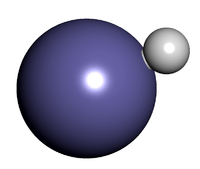Iron hydride

An iron hydride is a chemical system which contains iron and hydrogen in some associated form.[1][2]
Because of the common occurrence of those two elements in the universe, possible compounds of hydrogen and iron have attracted attention. A few molecular compounds have been detected in extreme environments (such as stellar atmospheres) or detected in small amounts at very low temperatures. The two elements form a metallic alloy above 35000 atmospheres of pressure, that has been advanced as a possible explanation for the low density of Earth's "iron" core.[2][3] However those compounds are unstable when brought to ambient conditions, and eventually decompose into the separate elements.
Small amounts of hydrogen (up to about 0.08% by weight) are absorbed into iron as it solidifies from molten state.[4] Although the H2 is simply an impurity, its presence can affect the mechanical properties of the material.
Despite the fleeting nature of binary iron hydrides, there are many fairly stable complexes containing iron-hydrogen bonds (and other elements).[5][6]
Overview
Binary compounds
Only a few compounds containing exclusively the two elements have been reported in technical literature, including:
- Iron(I) hydride (FeH). This molecule has been detected in the atmosphere of the Sun and some red dwarf stars. It is stable only as a gas, above the boiling point of iron, or as traces in frozen noble gases below 30 K (where it may form complexes with molecular hydrogen, such as FeH·H
2).[7] - Iron(II) hydride or ferrous hydride (FeH
2). This compound has been obtained only in very rarefied gases or trapped in frozen gases below 30 K, and decomposes into the elements on warming.[8][9] It may form a dimer Fe
2H
4 and complexes with molecular hydrogen, such as FeH2(H2)2 and FeH2(H2)3.[7][10] - Metallic Iron–hydrogen alloys. These include iron solidified from the melt at ordinary pressures, that may incorporate small amounts of hydrogen as an interstitial compound; and an intermetallic compound with formula FeH, stable at pressures above 3.5 GPa even at high temperatures and that is reported to survive for a while under ambient pressure, at temperatures below 150K.[11]
- What was once believed to be "Iron(III) hydride" or "ferric hydride"(FeH
3) was later shown to be FeH bound to molecular hydrogen H2.[10]
Iron-hydrogen complexes
Complexes displaying iron–hydrogen bonds include, for example:
- iron tetracarbonyl hydride FeH2(CO)4, the first such compound to be synthesised (1931).[6]
- FeH2(CO)2[P(OPh)3]2.
- Salts of the FeH2−
6 anion, such as magnesium iron hexahydride, MgFeH
6, produced by treating mixtures of magnesium and iron powders with high pressures of H2. - Di- and polyiron hydrides, e.g. [HFe2(CO)8]- and the cluster [HFe3(CO)11]-.
Complexes are also known with molecular hydrogen (H
2) ligands.
Biological occurrence
Methanogens, archaea, bacteria and some unicellular eukaryotes contain hydrogenase enzymes that catalyse metabolic reactions involving free hydrogen, whose active site is an iron atom with Fe–H bonds as well as other ligands.[12]
See also
References
- ↑ Greenwood, Norman N.; Earnshaw, Alan (1997). Chemistry of the Elements (2nd ed.). Butterworth-Heinemann. ISBN 0-08-037941-9.
- 1 2 J.V. Badding, R.J. Hemley, and H.K. Mao (1991), "High-pressure chemistry of hydrogen in metals: in situ study of iron hydride." Science, American Association for the Advancement of Science, volume 253, issue 5018, pages 421–424 doi:10.1126/science.253.5018.421
- ↑ Saxena, Surendra K.; Liermann, Hanns-Peter; Shen, Guoyin (2004). "Formation of iron hydride and high-magnetite at high pressure and temperature". Physics of the Earth and Planetary Interiors. 146 (1-2): 313–317. doi:10.1016/j.pepi.2003.07.030.
- ↑ A. S. Mikhaylushkin, N. V. Skorodumova, R. Ahuja, B. Johansson (2006), "Structural and magnetic properties of FeHx (x=0.25; 0.50;0.75)". In: Hydrogen in Matter: A Collection from the Papers Presented at the Second International Symposium on Hydrogen in Matter (ISOHIM), AIP Conference Proceedings, volume 837, pages 161–167 doi:10.1063/1.2213072
- ↑ Hiroshi Nakazawa, Masumi Itazaki "Fe–H Complexes in Catalysis" Topics in Organometallic Chemistry (2011) 33: 27–81. doi:10.1007/978-3-642-14670-1_2
- 1 2 Hieber, W.; F. Leutert (1931). "Zur Kenntnis des koordinativ gebundenen Kohlenoxyds: Bildung von Eisencarbonylwasserstoff". Naturwissenschaften. 19 (17): 360–361. doi:10.1007/BF01522286.
- 1 2 Wang, Xuefeng; Andrews, Lester (2009). "Infrared Spectra and Theoretical Calculations for Fe, Ru, and Os Metal Hydrides and Dihydrogen Complexes". The Journal of Physical Chemistry A. 113 (3): 551–563. doi:10.1021/jp806845h.
- ↑ Helga Körsgen, Petra Mürtz, Klaus Lipus, Wolfgang Urban, Jonathan P. Towle, John M. Brown (1996), "The identification of the FeH
2 radical in the gas phase by infrared spectroscopy". The Journal of Chemical Physics volume 104(12) page 4859 doi:10.1063/1.471180 - ↑ George V. Chertihin and Lester Andrews (1995), "Infrared spectra of FeH, FeH
2, and FeH
3 in solid argon" Journal of Physical Chemistry volume 99, issue 32, pages 12131–12134 doi:10.1021/j100032a013 - 1 2 Andrews, Lester (2004). "Matrix infrared spectra and density functional calculations of transition metal hydrides and dihydrogen complexes". Chemical Society Reviews. 33 (2): 123–132. doi:10.1039/B210547K. PMID 14767507.
- ↑ Antonov, V. E.; Cornell, K.; Fedotov, V.K.; Ponyatovsky, A. I. Kolesnikov E.G.; Shiryaev, V.I.; Wipf, H. (1998). "Neutron diffraction investigation of the dhcp and hcp iron hydrides and deuterides" (PDF). Journal of Alloys and Compounds. 264 (1-2): 214–222. doi:10.1016/S0925-8388(97)00298-3.
- ↑ Fontecilla-Camps, J. C.; Amara, P.; Cavazza, C.; Nicolet, Y.; Volbeda, A. (2009). "Structure-function relationships of anaerobic gas-processing metalloenzymes". Nature. 460 (7257): 814–822. doi:10.1038/nature08299. PMID 19675641.